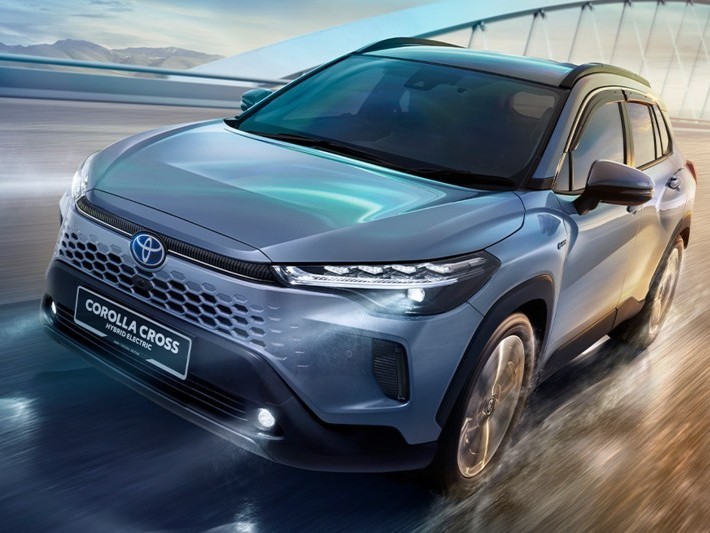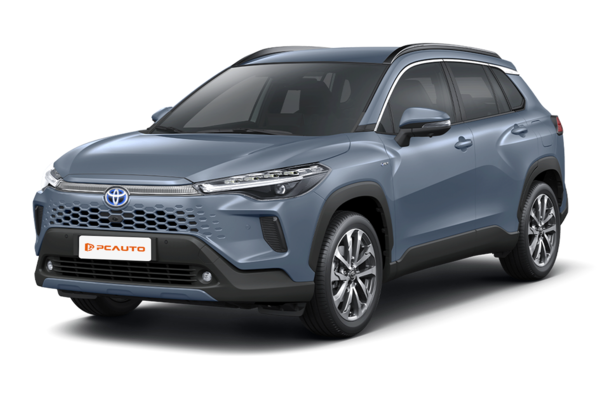Q
how to open toyota corolla cross trunk from inside
The Suzuki Jimny's 4x4 system is super easy to use, making it perfect for Malaysia's diverse road conditions. When you're cruising on regular paved roads, stick to 2H (two-wheel drive high) to save fuel. But when the going gets tough – think muddy trails, sandy patches, or steep slopes – you can switch straight to 4H (four-wheel drive high) either when the vehicle's stationary or moving slowly in a straight line (best to keep it under 100km/h, just to be safe). That splits the power evenly between all four wheels for extra grip.
For really extreme stuff, like deep mud or rocky climbs, you'll need to come to a complete stop, pop it into neutral, and then shift the transfer case to 4L (four-wheel drive low) – that's when you get maximum torque to crawl your way out. The dashboard's 4WD indicator light will light up to confirm the switch, so you know it's locked in.
Heads up though – leaving it in 4H or 4L on dry, paved roads for too long can overload the drivetrain. Only use those modes when you actually need the extra traction.
Another thing that makes the Jimny a solid off-roader is its ladder frame chassis and rigid axle suspension – they keep the body nice and stiff when you're bouncing over rough terrain. Pair that with the electronic limited-slip differential, which does a good job of stopping wheels from spinning, and it's a real workhorse for Malaysia's rainy season mud or those bumpy rural backroads.
For daily use, I'd recommend checking the transfer case fluid regularly. And when you're switching 4x4 modes, avoid mashing the gas – easy does it to keep that drivetrain happy and lasting longer.
Special Disclaimer: This content is published by users and does not represent the views or position of PCauto.
Related Q&A
Q
What is the wheelbase of the Toyota Corolla cross?
The Toyota Corolla Cross has a wheelbase of 2,640mm, which is slightly above average for its class of SUVs. This gives it a relatively spacious rear legroom while still keeping things nimble enough for city driving. Since wheelbase is one of the key factors in determining cabin space, it directly impacts passenger comfort and boot capacity—making the Corolla Cross a practical choice for daily family use or longer trips.
That said, vehicles with longer wheelbases tend to feel more stable at higher speeds but can have a slightly wider turning radius. Toyota’s engineers have tuned the chassis to strike a balance between these two traits. Built on the TNGA platform, the Corolla Cross also benefits from improved body rigidity and smarter space utilization, so that 2,640mm wheelbase works harder than the number might suggest.
Just keep in mind that wheelbase alone doesn’t tell the whole story—ground clearance, overall width, and even how efficiently a brand uses its wheelbase can affect real-world space. If you’re comparing options, a test drive is still the best way to judge.
Q
Is the 2023 Corolla Cross a good car?
The 2023 Corolla Cross is a well-rounded compact SUV that ticks all the right boxes for daily family use, backed by Toyota's reputation for reliability and practical design. It offers either a 1.8L naturally aspirated engine or a hybrid powertrain—both deliver solid fuel efficiency, with the hybrid notably cutting city driving costs while keeping maintenance affordable.
Inside, you’ll find flexible cabin space and a trunk that handles family trips with ease. Standard Toyota Safety Sense packs features like pre-collision alerts and lane-keeping assist, adding peace of mind on the road. The interior keeps things functional, with a 9-inch touchscreen supporting Apple CarPlay/Android Auto—right in line with what most buyers expect.
That said, don’t expect thrilling acceleration; the power delivery leans smooth rather than punchy, making it better suited for relaxed commutes. On the resale front, Toyotas generally hold their value well, but it’s worth cross-shopping rivals in this price range. Take it for a test drive to see if the suspension tuning and cabin noise levels match your preferences, and always double-check the dealer’s warranty fine print before signing.
Q
What is the safety rating of the Toyota Corolla 2021?
The 2021 Toyota Corolla excels in safety performance and has earned recognition from several international authoritative bodies. For instance, it achieved a five-star rating in Euro NCAP testing and was named a "Top Safety Pick" in IIHS crash tests in the United States. This model comes standard with the Toyota Safety Sense 2.0 active safety system, which includes features like a pre-collision system, lane departure alert, adaptive cruise control, and automatic high beams, providing comprehensive safety protection for drivers. In addition, the Corolla's body structure uses high-strength steel, effectively enhancing its impact resistance, and it is equipped with multiple airbags to further ensure passenger safety. For consumers considering purchasing this car, its safety performance is an important plus. Similar safety configurations in competing models are gradually becoming industry standards, indicating that automakers are placing increasing importance on safety performance. Consumers can pay more attention to these details when choosing a vehicle to ensure the driving safety of themselves and their families.
Q
Is the 2021 Corolla a good first car?
The 2021 Corolla makes a solid first car. It’s reliable, gets good gas mileage, and is super easy for new drivers to handle. Under the hood, you’ve got either a 1.8L or 2.0L naturally aspirated engine—smooth and built to last—paired with a CVT transmission that makes daily commuting a breeze while keeping fuel costs down. It also comes standard with Toyota Safety Sense, which includes pre-collision warning, lane keep assist, and adaptive cruise control—all stuff that really helps boost safety on the road. The interior is simple and functional, with decent space that works well for small families or singles. Maintenance costs are pretty reasonable too, and parts are easy to find, so owning it long-term is low-stress. If you want a bit more pep, the 2.0L version has quicker acceleration. It holds its value better than most in its class too, so you won’t take as big a hit when it’s time to trade up. Compared to other compact cars out there, it’s just really well-rounded—no major weaknesses. All in all, it’s a really safe bet for an entry-level ride.
Q
What kind of engine does the 2021 Corolla have?
The 2021 Corolla offers a range of engine options depending on the trim and configuration. The most common ones are the 1.8-liter and 2.0-liter four-cylinder naturally aspirated engines. The 1.8L puts out 139 horsepower, paired with a CVT transmission, and it's all about being economical and practical—perfect for daily commuting. Then there's the 2.0L, which cranks out 169 horsepower, delivering better performance for folks who want a more engaging driving experience. Some markets also get a 1.8L hybrid version that combines a gas engine with an electric motor for even better fuel economy.
Tech-wise, all these engines feature Dual VVT-i variable valve timing, which helps optimize fuel efficiency and power delivery. They're also known for being pretty reliable and durable, with relatively low maintenance costs. If you're thinking about buying a Corolla, pick the powertrain that fits your budget and needs. The 1.8L is great if saving gas is your top priority, the 2.0L suits drivers after more zip, and the hybrid can cut down on fuel costs even more over the long haul.
Q
What is the maintenance on a 2021 Toyota Corolla?
The regular maintenance for the 2021 Toyota Corolla mainly involves changing the engine oil and oil filter every 10,000 kilometers or 6 months, whichever comes first—this is the foundation for ensuring the engine runs smoothly over the long haul. The air filter should be inspected or replaced every 20,000 kilometers, and the cabin air filter is recommended to be changed annually or every 20,000 kilometers to keep the interior air quality fresh. Brake fluid needs replacing every 40,000 kilometers or 2 years. For CVT models, the transmission fluid should be checked every 80,000 kilometers and replaced if necessary, while spark plugs typically need swapping out at 100,000 kilometers. Also, regularly checking tire pressure, brake pad thickness, and the tightness of chassis bolts is crucial—these little details boost driving safety and cut down on long-term repair costs. It’s worth noting that as a globally best-selling model, the Corolla has relatively affordable maintenance costs, with plenty of original parts available and many third-party repair shops familiar with its structure, so owners can choose between original factory service or reputable third-party options based on their budget. If you want to further extend the vehicle’s lifespan, it’s advisable to get a comprehensive inspection every 50,000 kilometers, including the suspension system and drivetrain components. This helps spot potential issues early and avoids bigger losses down the line.
Q
How much is insurance on a 2021 Toyota Corolla?
The insurance cost for a 2021 Toyota Corolla typically ranges from RM1,500 to RM3,500 per year. The exact amount depends on factors such as the vehicle model, engine displacement, type of insurance coverage, and the owner's personal circumstances. Comprehensive insurance premiums are higher than third-party insurance. Key factors affecting premiums include the owner's age, driving record, vehicle usage location, and selected insurance add-ons. For example, younger owners or those living in accident-prone areas may need to pay higher premiums. To get a more accurate quote, it is recommended to enter specific information on the insurance company's official website or through an agency platform for calculation, and also compare the preferential schemes of different insurance companies. In addition, it is important to understand the deductible and claim scope in the insurance terms, as these details directly affect the actual compensation amount when making a claim. Regularly reviewing the insurance policy and adjusting the insured amount according to vehicle depreciation can help owners control insurance costs more reasonably in long-term use.
Q
How much does a battery cost for a 2021 Toyota Corolla?
The battery price for a 2021 Toyota Corolla typically ranges from RM500 to RM1000, depending on the battery type and brand. Original equipment (OE) batteries are more expensive but come with a longer warranty, while third-party brands like Amaron or Bosch offer better value for money with shorter warranties. It's recommended to choose a maintenance-free battery (MF battery) that meets the vehicle's specifications. These batteries don't require regular water refills and have a longer lifespan, usually 2 to 3 years. When replacing the battery, pay attention to specifications such as capacity (Ah) and cold cranking amps (CCA) to ensure compatibility with the vehicle's electrical system. Additionally, regularly checking the cleanliness and tightness of battery terminals helps extend battery life. If the vehicle is parked for an extended period, it's advisable to start it once a week to maintain battery charge. Choosing a reputable repair shop or authorized service center for battery replacement ensures quality installation and access to professional testing services.
Q
How long does a 2021 Corolla battery last?
The battery life of a 2021 Corolla typically ranges from 3 to 5 years, depending on usage habits and maintenance. If you often take short trips or leave it parked for long periods, the battery will wear out faster. Regularly checking the electrolyte level and keeping the terminals clean helps extend its life. Climate is also a big factor—hot weather speeds up battery aging, so it’s advisable to get a professional check every two years. Besides the original factory battery, there are plenty of high-performance alternatives on the market, like maintenance-free or AGM batteries, which are better suited for vehicles with frequent start-stop systems or added car electronics. In daily use, turning off the air conditioning and lights before shutting off the engine reduces battery strain. If you notice slow starting or the battery warning light on the dashboard comes on, have it checked promptly to avoid getting stranded. Most repair shops offer free battery testing services, making it easy for owners to stay on top of its condition.
Q
How long should a 2021 Toyota Corolla last?
The 2021 Toyota Corolla can typically hit 200,000 to 300,000 kilometers or more with regular maintenance and normal use. Its durability mainly comes down to Toyota's tried-and-true powertrain and solid manufacturing. The 1.8L or 2.0L naturally aspirated engines and CVT transmissions in this model have been market-tested for ages—keep up with regular oil changes, transmission fluid swaps, and other routine maintenance as per the manual, and those mechanical parts will hang in there a lot longer.
Day-to-day, pay extra attention to the cooling and ignition systems. If you're in a hot climate, shorten the coolant replacement interval, and if you mostly do short trips, keep an eye on the battery. For rust protection, the factory does a basic job, but coastal owners might want to add a chassis undercoat. Worth noting: the hybrid version, with its reduced engine load, could theoretically have an even longer-lasting powertrain.
At the end of the day, how long the car lasts depends a lot on how you drive and take care of it. Aggressive driving or constant overloading will wear things out faster, but smooth driving and sticking to the maintenance schedule will maximize its lifespan. On the used car market, Corollas with complete service records usually hold their value well—another sign of their long-term reliability.
Popular Cars
Model Year
Car Compare
Car Photo
Latest Q&A
Q
What is the rpm of 180 hp motor?
The powerband of a 180-horsepower engine varies by model and intended design. Naturally aspirated engines typically hit peak power at 6,000-7,000 rpm, while turbocharged units like common 1.5T or 2.0T engines often deliver maximum punch between 5,000-6,000 rpm.
Remember the horsepower equation "HP = Torque × RPM ÷ 5252"? That's why modern turbo engines feel punchier at lower revs while sipping less fuel - they're making the same power with fewer revolutions.
Real talk though: you'll rarely need to wring it out to redline in daily driving. Most scenarios call for just 3,000-4,000 rpm for decent shove. Holding high revs constantly? That's just wearing out your engine faster.
Brands tune these differently too - some prioritize low-end grunt for city crawling, while others build power up top for highway passing. Match your right foot's personality when choosing.
Q
What is the rpm of a 10 hp motor?
The RPM of a 10-horsepower (hp) motor depends on its type and intended use. Typically, standard AC induction motors run between 1,450 and 2,900 RPM, while DC or variable-frequency motors may have a wider range—check the nameplate or technical manual for specifics.
In automotive applications, like small generators or auxiliary systems, a 10-hp motor’s speed is often matched to the vehicle’s needs. For example, certain booster pumps or cooling fans might operate between 1,800 and 3,600 RPM.
Keep in mind that horsepower (hp) and RPM aren’t directly linked. HP reflects power output, while RPM depends on factors like pole count and supply frequency (e.g., a 4-pole motor in a 50Hz region runs around 1,440 RPM). If you’re swapping or modifying a motor, always verify the torque curve and load requirements to avoid efficiency losses or damage.
Also, in EVs or hybrids, motors often run at much higher speeds (8,000 RPM or more), though these systems usually rate power in kilowatts (kW)—just remember 1 hp ≈ 0.746 kW for conversion.
Q
How to convert HP into RPM?
To convert horsepower (HP) to RPM, you need to understand their relationship—but there’s no direct conversion since HP measures power while RPM reflects crankshaft speed. Torque bridges the gap. The formula is:
**HP = (Torque × RPM) / 5252** (with torque in lb-ft).
Rearrange it to solve for RPM:
**RPM = (HP × 5252) / Torque**.
For example, an engine making 200 HP at 300 lb-ft of torque hits roughly 3500 RPM at that output.
Keep in mind:
- Engines have unique powerbands—peak HP and torque rarely align at the same RPM.
- Turbocharging, aspiration, and transmission gearing all alter how power translates to wheel speed.
- Real-world performance isn’t just about this math; check the dyno curve and drivetrain setup for the full picture.
Q
What is the rpm of a 60 hp motor?
A 60-horsepower engine's RPM range depends entirely on its design and application. For small gasoline engines, you're typically looking at 6,000-8,000 RPM to hit 60 hp. Diesel mills, with their torque advantage, can achieve the same power at just 3,000-4,500 RPM - check the manufacturer's power curve for exact figures.
Remember, horsepower doesn't scale linearly with RPM. Cylinder count, induction type (naturally aspirated vs. forced induction), and fuel delivery all play major roles. Take turbocharged engines - they'll deliver peak power at significantly lower revs.
For daily driving, most cars operate most efficiently in the 2,000-3,000 RPM sweet spot where power and fuel economy balance out. Want specifics on your ride? Crack open the owner's manual or hook up an OBD scanner. Tuning enthusiasts can always flash the ECU to alter power delivery, but be warned - that warranty won't honor itself, and reliability might take a hit.
Q
How many rpm is a 2 hp motor?
There’s no fixed direct relationship between a motor’s RPM and its horsepower (HP), as rotational speed depends on factors like motor design, load conditions, and power supply frequency. For example, a 2 HP AC motor under a 50Hz power standard (common in household or industrial use) typically has a synchronous speed of around 1500 RPM or 3000 RPM—determined by its pole count (4-pole or 2-pole)—though actual operating speed may drop slightly under load.
For DC or brushless motors, the RPM range can vary more widely, so always check the specs for the specific model. Application also plays a role: a 2 HP motor for pumps or fans usually runs at moderate speeds, while power tools may prioritize higher RPMs.
When selecting a motor, don’t just focus on power—consider torque, efficiency, and rated speed to match real-world needs. For precise figures, consult the manufacturer’s datasheet or a technical expert.
View MoreRelated News

Should I choose the top-tier Toyota Corolla Cross, or the entry-level Fortuner?
Kevin WongNov 6, 2025

The Tiggo 7 PHEV, conversely, gains traction among younger buyers by offering a lower price point and a more technologically advanced package.
JamesOct 15, 2025

Toyota Corolla Cross mid-term facelift in China, featuring a new front face and interior design
AshleySep 29, 2025

Toyota Corolla Cross Design Revealed: A Versatile Model Combining Practicality and Comfort
AshleyJul 16, 2025

Toyota Unveils All-New Corolla Cross, Introduces GR SPORT Trim for the First Time
JohnMay 8, 2025
View More


















Pros
Cons